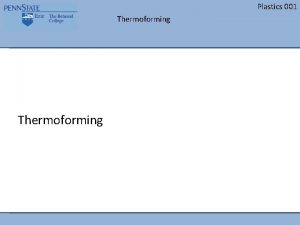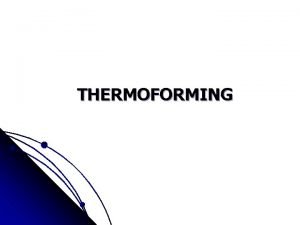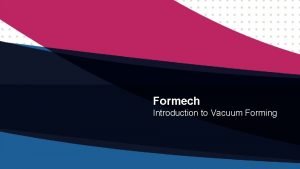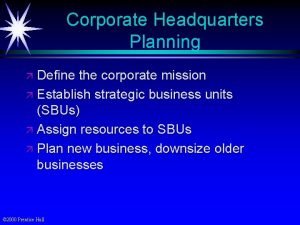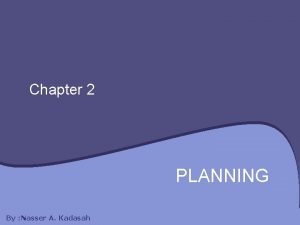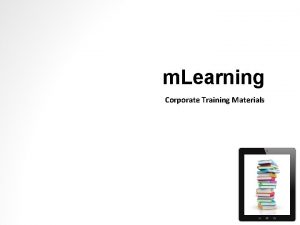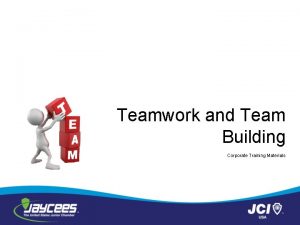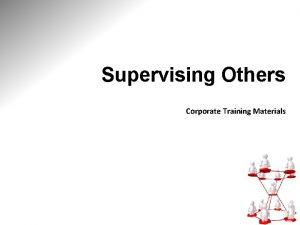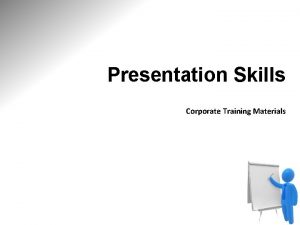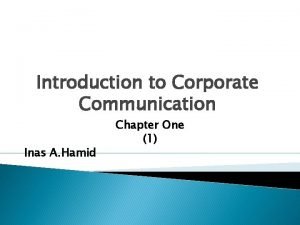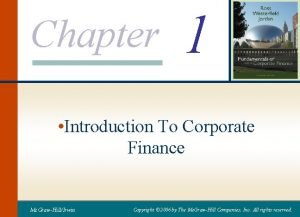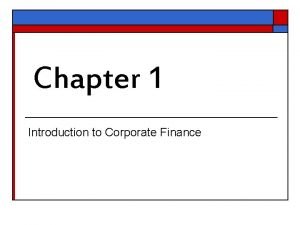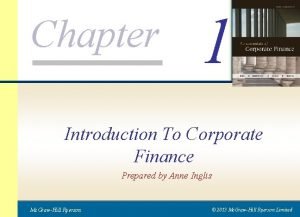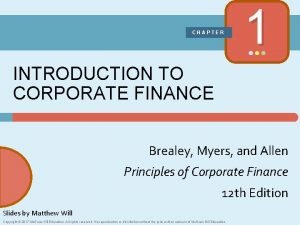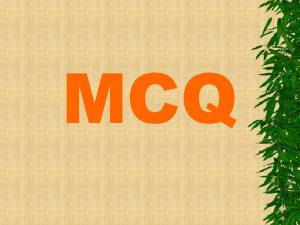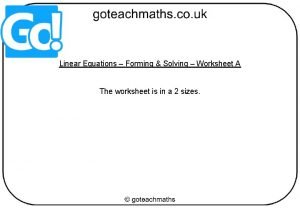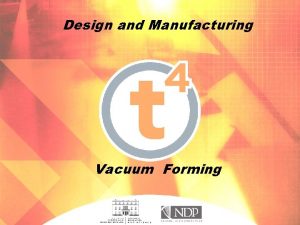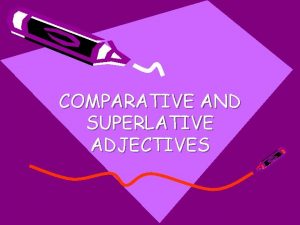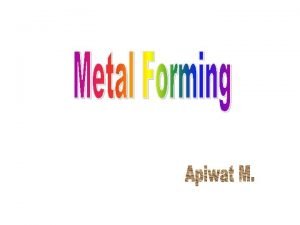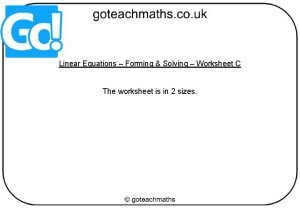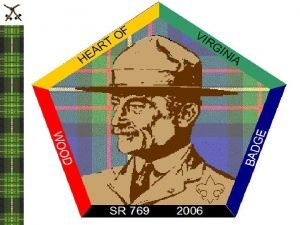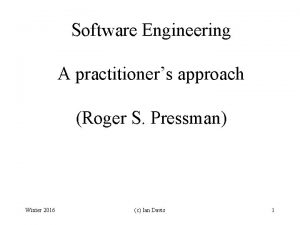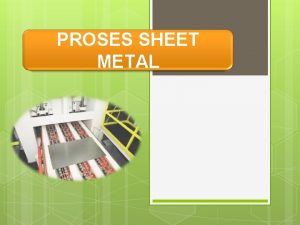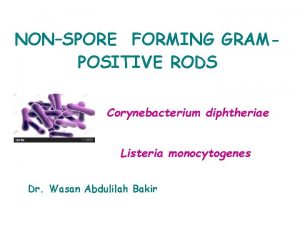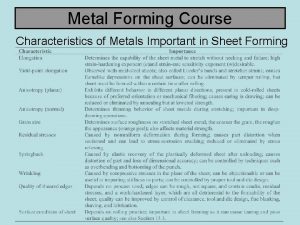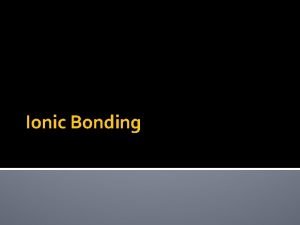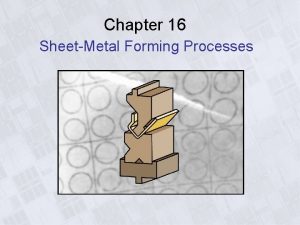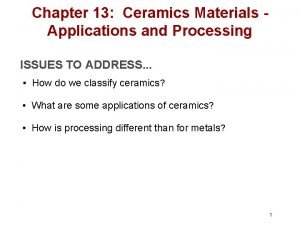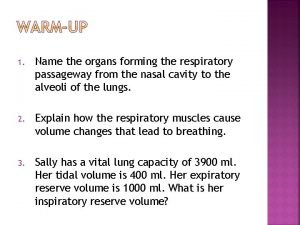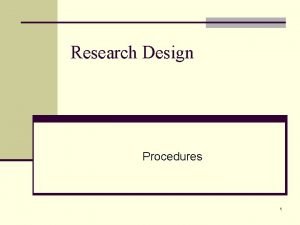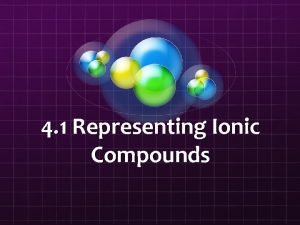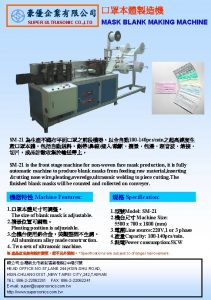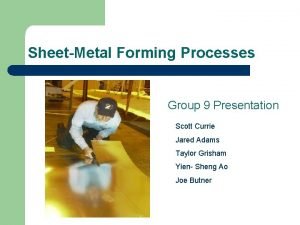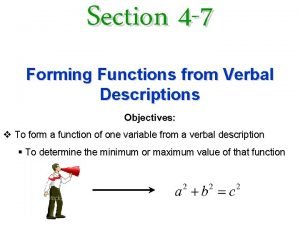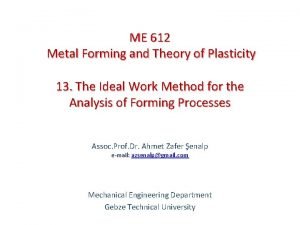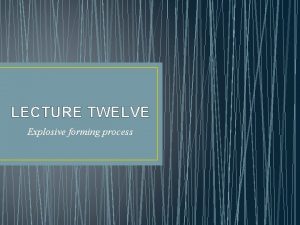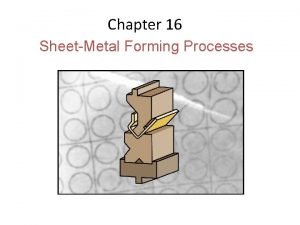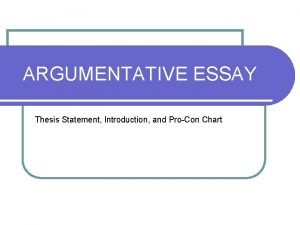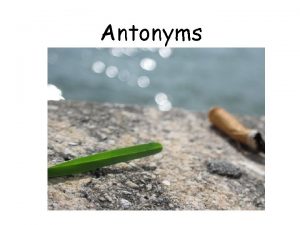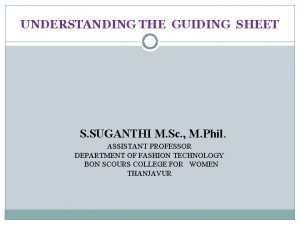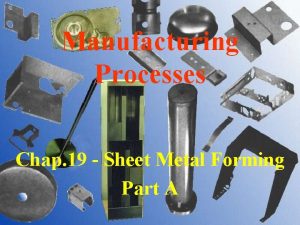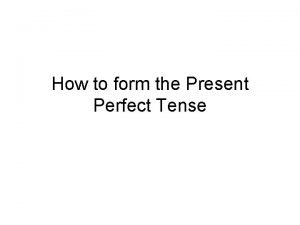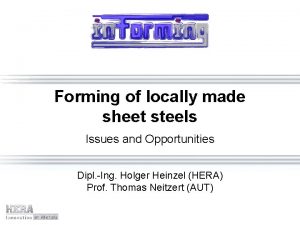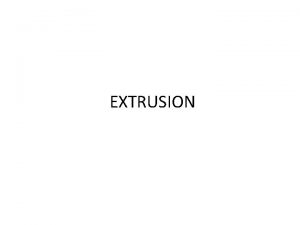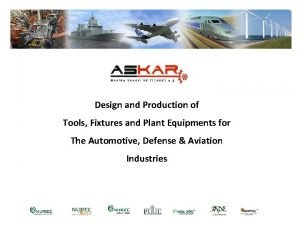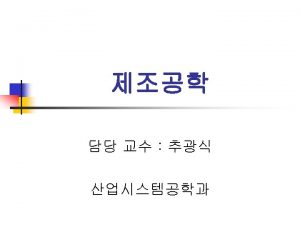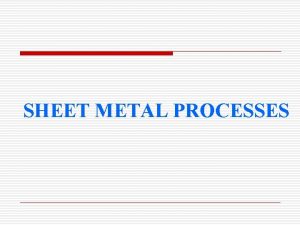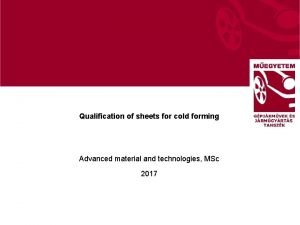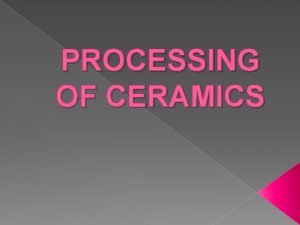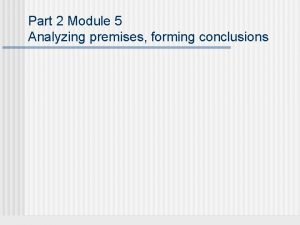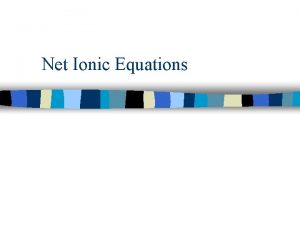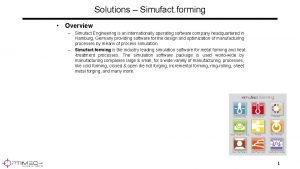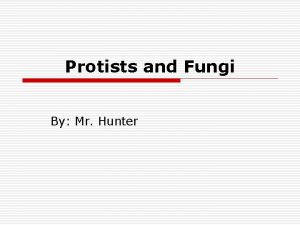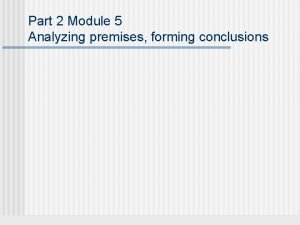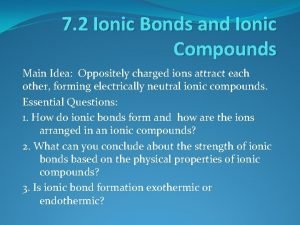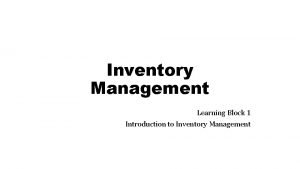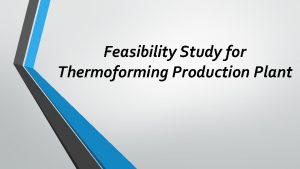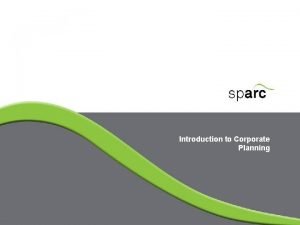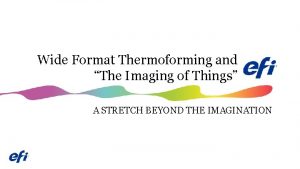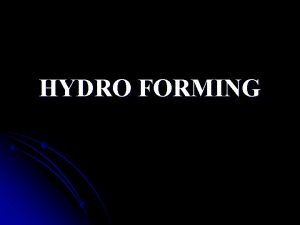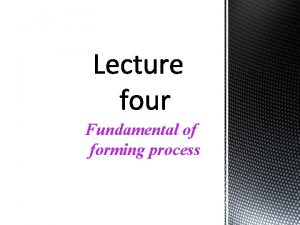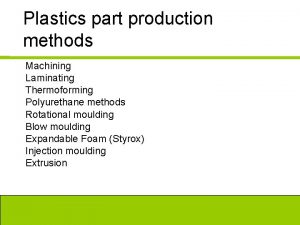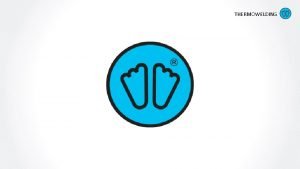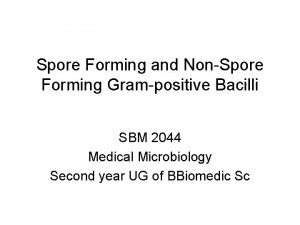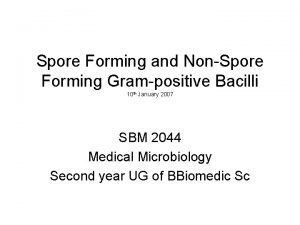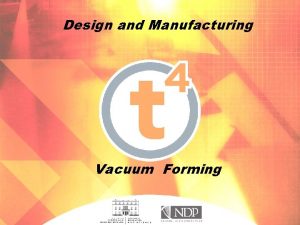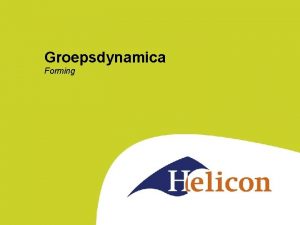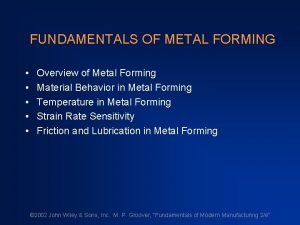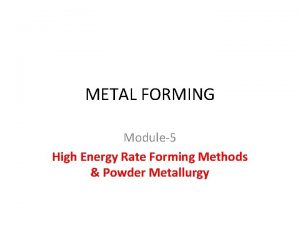5 THERMOFORMING CORPORATE TRAINING AND PLANNING INTRODUCTION Forming


































































































- Slides: 98

5. THERMOFORMING CORPORATE TRAINING AND PLANNING

INTRODUCTION • • Forming. The plastic sheet retains the moulds shape and details. process The • involves thermoplastic heating a sheet to its softening temp (pliable State). • Processing or forcing the hot & flexible sheet against the contours of mould by applying vacuum or air pressure. • The sheet is held there for cooling and then removed. • Thermoforming is secondary processing technique. CORPORATE TRAINING AND PLANNING 2

• • soften it. thickness of the part as compared to other parts. • The essential characteristics of thermoplastic sheet material should be such that when they are heated to just below melting point they should become rubbery or plastic in nature to an extent which enables them to be stretched out rather like a balloon. CORPORATE TRAINING AND PLANNING 3

CORPORATE TRAINING AND PLANNING 4

APPLICATION • Refrigerator door liners • Cheese containers • Soft drink cups • Signs • Packaging of Tablets and capsules CORPORATE TRAINING AND PLANNING 5

• Ice cream cups • Plastic tray • Helmets • Telecommunication Joints • Luggage • Light and instrument panels. CORPORATE TRAINING AND PLANNING 6

CORPORATE TRAINING AND PLANNING 7

CORPORATE TRAINING AND PLANNING 8

CORPORATE TRAINING AND PLANNING 9

CORPORATE TRAINING AND PLANNING 10

ADVANTAGES • Tooling cost is inexpensive. • Suitable for large parts • Thin walled components can be made by this method only. • Suitable for small number of parts, samples, prototypes etc. • Low capital cost. • Moulds can readily modified and quickly changed. CORPORATE TRAINING AND PLANNING 11

LIMITATION • material only. made parts the All be • this process to by must have uniform well thickness. • Ribs or mounting bosses cannot be made. CORPORATE TRAINING AND PLANNING 12

MATERIALS CHARACTERISTIC FOR THERMOFORMING 1. Ability of the materials to be deep drawn without tearing. 2. Plastic Memory. 3. Good hot melt strength. 4. Hot Elongation. 5. Forming temperature range a. Wide range is preferred b. No sharp melting point should be there. CORPORATE TRAINING AND PLANNING 13

TYPES OF MATERIAL USED Ø Basically thermoplastic thermoforming process. materials used for Ø Such types of material when heated will exhibit a reduction in their modulus of elasticity, their stiffness and load bearing capacity. CORPORATE TRAINING AND PLANNING 14

Ø A wide softening range, i. e a broad temperature span in which plastic is soft, pliable and elastic is desirable since, during thermoforming process the temperature of material drops rapidly. Ø High molecular weight thermoplastics mostly preferred for thermoforming. Ø The material to be thermoformed should have higher thermal expansion. Ø The thermal stability of the material must be good. Thermal diffusivity is ideal for establishing cooling time for thermoformed parts. CORPORATE TRAINING AND PLANNING 15

Thermal Diffusivity = Thermal Conductivity Density X specific heat Ø The water absorption capacity of the plastic material should be low for thermoforming, because slow rate of water absorption also causes difficulties in thermoforming CORPORATE TRAINING AND PLANNING 16

PLASTIC MATERIALS FORMING PS, ABS, PVC, PMMA, CAB, PC, HDPE, PP CORPORATE TRAINING AND PLANNING 17

MATERIAL PREPARATION Ø Most available sheet materials are prepared by sheet extrusion process which employs medium to high molecular weight polymers that are subjected to minimal heat stress. Ø Sheets with excellent optical properties are obtained either by casting or by laminating and / or press polishing of otherwise manufactured sheets. CORPORATE TRAINING AND PLANNING 18

SHEET FOR THERMOFORMING The sheets are manufactured from : • Extrusion Process • Calendaring Process • Casting Process The sheet thickness ranges from 0. 25 mm to 12. 5 mm CORPORATE TRAINING AND PLANNING 19

THERMO FORMING MOULD Mould Materials (i) Plaster of Paris : Ø Most commercial moulding, plasters are not strong enough to be used in prototyping. Ø Plasters are inorganic calcious materials that hydrolytically react and harden when mixed with water. CORPORATE TRAINING AND PLANNING 20

Ø Soaps such as Murphy’s Oil soap, found in lather goods stores can also be used as a surface release agent. Vents should be designed in by placing release-agentcoated wires perpendicular to the pattern surfaces before coating. Ø A very hard surface (Void-free) can be achieved by “Splitting” a thin layer of relatively high water content plaster slurry against the pattern. CORPORATE TRAINING AND PLANNING 21

Advantages : Cheap, quick, possible. and intimate production of details is Disadvantage : A maximum of only about 50 forming is possible, the surface being very soft and the mould itself is very fragile. CORPORATE TRAINING AND PLANNING 22

(ii) Wood : Ø production. Ø shaping to minimize stress relief during fabrication. Ø After thorough drying, the surface can be sealed with temperature–resistant enamel or varnish. Ø developed that protect wood surface for hundreds of cycles with out refinishing. CORPORATE TRAINING AND PLANNING 23

Advantages : Cheap, longer life span than plaster moulds, higher impact strength. Disadvantages : Limited life say for approximately 500 forming. During repeated forming, wooden mould should not be allowed to become too hot and its dimensions should be checked regularly. CORPORATE TRAINING AND PLANNING 24

(iii) Plastic moulds: Ø In particular, plastic tooling is economically preferred for thick sheet forming. Ø Plastic moulds are used where mould surface temperature do not exceed 60 o. C. where drape or vacuum forming used, epoxy and unsaturated polyester resin (UPE) together with glass fiber are the mould materials of choice. CORPORATE TRAINING AND PLANNING 25

Advantages: 1. Fairly cheap, easily manufactured, low thermal conductivity, little or no finish is required, lasts long. Disadvantages: 1. Some materials are sensitive to high forming temp. 2. mould surface must be adequately cleaned, waxed and buffed prior to use. CORPORATE TRAINING AND PLANNING 26

iv) Aluminium moulds: luminium Ø thermo forming moulds. Because Ø high thermal conductivity and so sensible heat from plastic material can easily be removed. Ø It is light weight, tough metal. Ø machined plate or caste material. CORPORATE TRAINING AND PLANNING 27

Ø The Aluminium mould mostly consists of 1 to 2 % Cu. , 0. 5 to 1% mg, 0. 5% Mn, 4 to 8% Si, 1% (max) Fe, 15 Ni and traces of Ti and Zn. Ø Typical machined aluminium hardness is 130 Brinell and Aluminium has relatively high thermal expansion coefficient. Advantage: CORPORATE TRAINING AND PLANNING 28

HEATING SYSTEMS (i) Convection Ovens: Ø Convection ovens are originally the most common device used to heat plastic sheets for thermoforming. Ø The heat can be supplied by gas flames or by electric resistance units. CORPORATE TRAINING AND PLANNING 29

Ø Forced circulation of air and baffling to equalize the air flow at around 200 feet per minute are crucial to obtain temperature uniformity. Ø Good thermal insulation of the oven walls and the strategical position and size of entrance and exit doors increase energy efficiency. Ø Automatic temperature regulators must be provided to keep air temperature fluctuation as low as possible. CORPORATE TRAINING AND PLANNING 30

(ii) Infrared Radiant Heaters Ø Besides dialectic heating, oil submersion heating and contact heating, IR radiant heating is the fastest way of heating plastic sheet or films to thermoforming temperature. Ø Although heater densities may vary with equipment, there also differences in regard to materials. CORPORATE TRAINING AND PLANNING 31

Ø High temperature plastics, such as polycarbonates and polyesters are the highest, with about 30 watt/sq. Ø The cellulosic, styrene and vinyl Polymers are the lowest 15 watts/sq. Thin films can be heated at higher energy densities in a considerably short time. CORPORATE TRAINING AND PLANNING 32

(iii) Electrically Powered Infrared Heaters Ø Electrically powered infrared heaters are available in a wide range of designs. In order of decreasing radiant surface temperatures (i. e. increasing wave length of energy emitter). They are: Ø Tungsten wire filament heaters in quartz tubes and tungsten wire filament glass lamps. CORPORATE TRAINING AND PLANNING 33

Ø Nichrome wire coil heaters in quartz glass tubes. Ø Nichrome wire or band in refractory materials embedded or surrounded and protected by stainless steel round. Ø Heat distribution over entire sheet is more uniform in case of radiant heaters than hot air convection ovens. CORPORATE TRAINING AND PLANNING 34

STRETCH RATIO A sheet of plastic initially of thickness to and surface area Ao is stretched to provide a part having a surface area A (A > Ao) and an average thickness ta (ta < to) The plastic volume given by : V = to. Ao = td. A = ta. A The stretch ratio is given by : Ra = A/Ao or Area ratio Other wise called areal draw ratio CORPORATE TRAINING AND PLANNING 35

DIFFERENT FORMING PROCESSES • Straight Vacuum Forming Process. • Pressure forming • Plug-Assist Forming • Free forming • Drape forming • Snap-back forming • Matched-die forming • Mechanical forming CORPORATE TRAINING AND PLANNING 36

STRAIGHT VACUUM FORMING • This techniques is most versatile and widely used. • The plastic sheet is clamped in a frame and heated. • The hot sheet becomes rubbery or elastic. • Then it is placed over a female mould cavity. • The vacuum is now applied. CORPORATE TRAINING AND PLANNING 37

• The atmospheric pressure forces the hot sheet against the walls and contours of the mould. • It is allowed to cool there. • The formed part is removed and final finishing and decoration is done. CORPORATE TRAINING AND PLANNING 38

• This technique is used when the outside of the part (the side against the mould) must have fine details or close tolerances. • This process is limited to draw ratio of 1 ½. • Draw ratio is the ratio of the draw dept to the part width. CORPORATE TRAINING AND PLANNING 39

FIGURE CORPORATE TRAINING AND PLANNING 40

PRESSURE FORMING • It is similar to straight vacuum forming process. • Here also plastic is formed in a female mould. • Here instead of applying vacuum a positive air pressure on the top of the plastic is used to force the material against the female mould. CORPORATE TRAINING AND PLANNING 41

PROCESS • The sheet is clamped and heated till softened. • moulding area and a seal is made so that the upper chamber, above the plastic is airtight. • done with vacuum farming. • softened plastic and vacuum is created below it. • The air pressure and the vacuum forces the plastic against the mould. CORPORATE TRAINING AND PLANNING 42

CORPORATE TRAINING AND PLANNING 43

ADVANTAGES • Moulding cycle is faster. • The sheet can be formed at lower temp because the forming pressure is higher. • A greater dimensional control and part definition can be achieved. CORPORATE TRAINING AND PLANNING 44

PLUG ASSIST FORMING • A male plug is used. • Plastic sheet is clamped in the female mould and after the heat-softened sheet is sealed across the mould cavity, the plug pushes the sheet to stretch it. • After completion of penetration stroke vacuum and /or compressed air is introduced to transfer the sheet from the plug surface to the cavity mould surface. CORPORATE TRAINING AND PLANNING 45

• Plugs are made up of metal, wood or thermoset plastic. • Plug is heated to a few degree less than the temp of the plastic in order to prevent premature cooling. • The plug size combined with the rate and depth of penetration affect the amount of stretching that occurs. CORPORATE TRAINING AND PLANNING 46

CORPORATE TRAINING AND PLANNING 47

ADVANTAGES • Deeper and more uniform wall thickness is obtained. • It is also responsible for the ultimaterial distribution in the finished product. CORPORATE TRAINING AND PLANNING 48

FREE FORMING • The sheet is expanded with pressure. • The size of bubble is monitored by an electronic eye. • When the bubble reaches the desired size, the air pressure is reduced to a level that maintains the size of the bubble while the part cools. CORPORATE TRAINING AND PLANNING 49

ADVANTAGES • The products have very high optical clarity. • No mould is used. • No transfer or handling of the sheet. • Simple and Economical • Uniform cooling. CORPORATE TRAINING AND PLANNING 50

DISADVANTAGES • Complexity of shapes can’t be made. • The control over the shape is difficult. CORPORATE TRAINING AND PLANNING 51

DRAPE FORMING • The plastic sheet is clamped and heated. • Then drawn over the mould either by pulling it over the mould or by forcing the mould into the sheet. • The seal is created. • Vacuum is applied beneath the mould and forces the sheet over the male mould. • By draping the sheet over the mould, that part of the sheet which is touching the mould remains close to the original thickness of the sheet. Side walls are formed from the material draped between the top edges of the mould and bottom seal area at the base. CORPORATE TRAINING AND PLANNING 52

CORPORATE TRAINING AND PLANNING 53

ADVANTAGES • Greater depths of draw can be achieved without excessive thinning compared to forming in a female mould. • Uniformity of thickness is much better. CORPORATE TRAINING AND PLANNING 54

SNAP-BACK FORMING • It is the modified form of Drape forming. • The sheet is heated to the sag point. • Then it is drawn slightly into a vacuum box below the part. • This pre-stretching creates thinning effect at the center of the part. It is generally to 1/2 to 2/3 of total draw. CORPORATE TRAINING AND PLANNING 55

• A second step is then activated to give more draw i. e the male mould is pressed against the material to draw it further. • During this stage, the thickness of the material is constant at center and thinning occurs near the edge. CORPORATE TRAINING AND PLANNING 56

• Finally the part is formed by applying a vacuum through the male mould and causing the part to snap back against the outside of mould. • The part cools against the mould to take its final shape. CORPORATE TRAINING AND PLANNING 57

CORPORATE TRAINING AND PLANNING 58

Advantages : • Uniform wall thickness • Complex shape can be formed. Disadvantages : • Longer cycle time. CORPORATE TRAINING AND PLANNING 59

APPLICATIONS • Many cases & luggage sheets. • Computer Housing. • Acrylic cast sheets etc. CORPORATE TRAINING AND PLANNING 60

MATCHED DIE FORMING • This method resembles to that of compression moulding. • The plastic sheet is heated to the sag point. • It is trapped and formed between male and female dies. • The clearance between the male and female dies decide the wall thickness. CORPORATE TRAINING AND PLANNING 61

• Vent holes on both mould is provided to avoid the entrapment of air. • Moulds are placed until the plastic cools and cures. • No vacuum air pressure is applied in this process. • Mould materials are generally wood, plaster, epoxy or others. CORPORATE TRAINING AND PLANNING 62

CORPORATE TRAINING AND PLANNING 63

ADVANTAGES • Very good reproduction of mould details. • Very good dimensional accuracy. • Lettering and grained structure can be easily formed. DISADVANTAGE • Internal cooling of mould is desirable. CORPORATE TRAINING AND PLANNING 64

MECHANICAL FORMING • The sheet is clamped and heated. • Mechanical pressing is done against the inside of a forming tool such as bracket to give the desired shape. • The plastic sheet cut to appropriate shape and size and then heated to the sag point. CORPORATE TRAINING AND PLANNING 65

• The pressing can be done by a roller, a block or any other instrument to apply a relatively uniform pressure on the plastic sheet, when it is still hot to create the desired shape. • The formed plastic sheet is cooled in that place. CORPORATE TRAINING AND PLANNING 66

INLINE THERMOFORMING PROCESS Ø Inline thermoforming mainly meant continuous sheet forming & production. for the Ø If the forming process can be accomplished during the time it takes to extrude the sheet and if long production runs are involved, inline extruder thermoformer could be considered. CORPORATE TRAINING AND PLANNING 67

ADVANTAGES Ø The advantages is that the materials is already available in very uniform temperature and it might not have to be preheated. Ø Any cut-outs, margins and trim materials can continually be regrinded and re-extruded, thus solving the problem of eliminating scrap material. CORPORATE TRAINING AND PLANNING 68

Ø Since the virgin regrind ratio remains constant for each product, the disturbances found when external regrinds are reprocessed are avoided. Ø Improved extruder technology and the increased use of gear pumps, which eliminate extrusion surging helps too. CORPORATE TRAINING AND PLANNING 69

DISADVANTAGES The problem arising at any point may require the shut down of the whole production line and that no pre-printing of the sheet is possible. CORPORATE TRAINING AND PLANNING 70

CO-EXTRUSION AND LAMINATES Ø Co-extruded and laminated sheets have gained favour for thermoforming process since for many applications. Ø By the term co-extrusion is meant the formation of sheet produced by simultaneously employing two or more extruders. CORPORATE TRAINING AND PLANNING 71

Ø The term laminate should always be employed when either two or more previously extruded or calendered sheets combined or bonded. Ø Usually laminates are obtained by pressing several layers between Chrome Plated Steel Sheets. CORPORATE TRAINING AND PLANNING 72

Ø Co-extruded products and laminates are used when : 1. Parts are required which have different colours on the inner and outer surface, and plain coat of paint is not adequate. 2. Parts are subjected to ultra violet radiation on the outside, but lower cost material suffices to provide mechanical strength. 3. low cost grind or scrap materials ( of undesirable colour) are available but parts with high quality appearance are demanded. CORPORATE TRAINING AND PLANNING 73

Thermoforming Injection moulding Thermoforming requires more expensive sheet as raw stock Injection moulding uses material in granule form which is cheapest form of raw material Thermoforming dies are Here the mould cost is made up of wood, plaster very high. of Paris, aluminium and its cost is substantially low. If the number of articles to Injection moulding is be moulded is less then suitable for large the choice would be production. thermo forming. CORPORATE TRAINING AND PLANNING 74

Thermoforming operation sets up quickly. Injection moulding operation takes more time. Thermoforming sheet can be printed or decorated before forming In Injection Moulding decoration is not possible before processing. Holes and undercuts cannot be produced by thermoforming Holes and undercuts be produced by injection moulding. Thermoforming is adaptable to the production of very large parts such as trailers roof. Injection moulding produces not as large part as thermoforming. CORPORATE TRAINING AND PLANNING 75

Thermoforming parts Injection moulded in parts require final trimming don’t require any final operation trimming operation. Pressure required is lower Pressure requirement is than injection moulding very high. Here scrap Production is Scrap production is very high low. Lower machine original Higher original machine cost. CORPORATE TRAINING AND PLANNING 76

THERMOFORMED PRODUCTS AND ITS APPLICATION CORPORATE TRAINING AND PLANNING 77

(i) Packaging and related items Ø Blister packs. Ø Bubble packs. Ø Cosmetics, Cases, Packages, Ø Meat, Poultry trays Ø Wide mouth jars. Ø Vending machine hot cup. Ø Egg Cartoons. (ii) Vehicular Ø Automotive door inner liners. Ø Windshields. Ø Motorcycle windshields, Mud guards. Ø Recreational vehicle interior components. Ø Window Blisters. CORPORATE TRAINING AND PLANNING 78

(iii) Industrial Ø Pallets Ø Part Trays, Transport trays Ø Equipment Cases. (iv) Building Products Ø Shutters, Windows. Ø Skylights, Translucent Domes. Ø Exterior lighting shrouds. Ø Storage modules, Bath-Tubs. (v) Others Ø Exterior Signs, Luggage trays. Ø Boat Hulls (with PUR foam) Ø Advertising signs. Ø Lighted indoor signs. CORPORATE TRAINING AND PLANNING 79

FAULTS, CAUSES & REMEDIES IN THERMOFORMING PROCESS CORPORATE TRAINING AND PLANNING 80

PROBLEM PROBABLE CAUSE REMEDIAL ACTION (a) Heating too rapidly Ø Lower heater temperature Ø Use slower Heating Ø Increase distance between heaters and sheet. Blow air across sheet surface during Heating. (b) Excess Moisture Ø Predry sheet Ø Pre heat sheet Ø Heat from both the side. (c) Uneven Heating Ø Check heat out power consumption. Ø Use pattern heating. BLISTERS CORPORATE TRAINING AND PLANNING 81

(a) Sheet too Cold Ø Ø (b) Insufficient Vacuum Ø Check vacuum holes for obstruction. Ø Increase number of vacuum holes. Ø Increase diameter of vacuum holes. INCOMPLETE FORMING Heat sheet longer. Raise heater temperatures. Use more heaters. Change to more efficient heater design. CORPORATE TRAINING AND PLANNING 82

(c) Vacuum not applied rapidly enough. Ø Use vacuum slots rather than holes. Ø Too many bends in vacuum line. Ø Check vacuum leaks. (d) Applied pressure too low. Ø Increase air pressure. Ø Use plug, silicone slab rubber, or Bladder as plug assist. CORPORATE TRAINING AND PLANNING 83

SCORCHED SHEET (a) Sheet surface too hot. Ø Shorten heat cycle. Ø Use slower, soaking Heat. Ø Consider convection heating. CORPORATE TRAINING AND PLANNING 84

COLOUR INTENSITY CHANGE (a) Insufficient Heating ØLength heating cycle. ØRaise heater temperature. ØChange to more efficient heaters. (b) Excess Heating ØReduce heater temperature. ØShorter heating cycle. ØIf localised, check heater efficiency. CORPORATE TRAINING AND PLANNING 85

(c) mould too Cold ØWarm the mould (d) Sheet cools before fully formed. Ø Transfer sheet faster. Ø Increase forming rate. Ø Increase mould, plug temperature. (e) Poor mould design Ø Reduce draw ratio. Ø Increase draft angle. Ø Increase corner radius. CORPORATE TRAINING AND PLANNING 86

(a) Stretching ØIncrease sheet temperature. below forming ØIncrease forming speed. temperature. (b) Sheet Dry. WHITENING coloured Ø Poor extrusion. Ø Material unsuitable for pigmentation. Ø Local blemished removed with hot air gun. CORPORATE TRAINING AND PLANNING 87

(a) Poor Vacuum ØIncrease vacuum hole area. ØCheck plugged vacuum holes. (b) mould Too Hot ØReduce mould temperature. SURFACE (c) mould Too Cold BLEMISHES (d) Rough mould surface (e) Scratched sheet ØIncrease mould temp. ØPolish mould. ØUse Aluminium moulds ØInspect handling procedures. ØUse Polish Sheet CORPORATE TRAINING AND PLANNING 88

Ø Check heater temperature. Ø Pattern Heat. SHINY (a) Local overheating STREAKS Ø Air cool locally. Ø Reduce Heating Cycle. CORPORATE TRAINING AND PLANNING 89

(a) Uneven part cooling Ø Change coolant channel configuration. (b) Poor material distribution in part wall. Ø Use Pre-stretching or plug assist. Ø Poor temperature uniformity. WARPED PARTS (c) Poor mould Design (d) mould temperature too low Ø Increase vacuum hole area. Ø Redesign rim area to stiffen. Ø Add plugged vacuum holes. Ø Increase mould temperature to just below material set temperature. CORPORATE TRAINING AND PLANNING 90

SHRINK MARK (a) Inadequate Vacuum ØVacuum leak ØPlugged vacuum holes. ØVacuum hole are inadequate. (b) Surface too smooth Ø Roughen mould surface. Ø Change to lower conductivity mould material (c) Part shrinking during forming ØIncrease forming pressure. ØIncrease mould temperature. ØChange to less elastic material. (d) Inadequate air pressure Ø Increase air flow rate. Ø Increase air pressure. Ø Increase cycle time pressure. CORPORATE TRAINING AND PLANNING under 91

(a) Part temperature too high ØIncrease cooling time ØLower mould temperature. ØReduce heating time PARTS (b) Inadequate Draft STICK IN mould ØRework mould for more draft. ØUse female mould. ØRemove part early. (c) mould undercuts Ø Remove part early Ø Consider more sophisticated ejection system. CORPORATE TRAINING AND PLANNING 92

(d) Sticking in one spot Ø Uneven mould temperature. Ø Uneven sheet temperature prior to forming. Ø Vacuum brake inadequate. (e) Wooden mould ØLubricate with dry mould release. (f) Rough mould surface ØPolish especially corners. ØUse dry mould release. CORPORATE TRAINING AND PLANNING 93

(a) mould Design ØIncrease corner Radius. (b) Sheet is too hot Ø Decrease sheet temperature. Ø Preheat sheet, then bring forming. Ø Sheet thickness may not be uniform. SHEET TEARS WHILE FORMING (c) Sheet too cold (d) Improper material ØIncrease heating time. ØPreheat sheet. Ø Depth of draw excessive for material. Ø Change forming technique. CORPORATE TRAINING AND PLANNING 94

ØIncrease radii. ØCorner too cold during forming. CORNER (a) Stress ØIncrease mould temperature. CRACKING Concentration IN SERVICE ØIncrease sheet temp. ØIncrease forming rate. CORPORATE TRAINING AND PLANNING 95

Excessive Sag a) Sheet too hot (a) Reduce Heater temp. (b) Reduce Heating Cycle b) Melt index too high (a) Use lower MI Olefin. (b) Change Resins. (c) Increase sheet orientation. (c) Sheet area excessive (a) Pattern Heat to reduce temperature of sheet centre. (b) Add sag bands. CORPORATE TRAINING AND PLANNING 96

(a) Incorrect forming technique VERY THIN CORNERS (b) Sheet too thin ØTry Plug assist ØIncrease sheet thickness CORPORATE TRAINING AND PLANNING 97

(c) Sheet temperature variation ØCheck Material allocation. ØPattern heating ØIncreased rate of forming (d) Variation in mould temperature ØChange coolant line configuration. ØCheck free surface cooling. (e) Incorrect material ØUse stiffer resin ØUse more elastic resin CORPORATE TRAINING AND PLANNING 98
 Thermoforming advantages and disadvantages
Thermoforming advantages and disadvantages Proses thermoforming
Proses thermoforming Formech
Formech Objectives of corporate governance
Objectives of corporate governance Corporate headquarters planning
Corporate headquarters planning Importance of corporate planning
Importance of corporate planning Corporate training materials
Corporate training materials Corporate training materials
Corporate training materials Stebah
Stebah Corporate training materials reviews
Corporate training materials reviews Account takeover examples
Account takeover examples Introduction to corporate communication
Introduction to corporate communication Introduction to corporate finance what companies do
Introduction to corporate finance what companies do Purpose of corporate governance
Purpose of corporate governance Damodaran beta
Damodaran beta Chapter 1 introduction to corporate finance
Chapter 1 introduction to corporate finance Chapter 1 introduction to corporate finance
Chapter 1 introduction to corporate finance Chapter 1 introduction to corporate finance
Chapter 1 introduction to corporate finance Forming and welding mcq
Forming and welding mcq Forming and solving equations worksheet
Forming and solving equations worksheet Forming equations worksheet
Forming equations worksheet Hot working of metals
Hot working of metals Vacuum forming tips
Vacuum forming tips Comparatives and superlatives lucky
Comparatives and superlatives lucky Wholesale cold forming metal
Wholesale cold forming metal Forming and solving equations worksheet
Forming and solving equations worksheet Inactivism planning
Inactivism planning Long term plan and short term plan
Long term plan and short term plan Corpus planning definition
Corpus planning definition Introduction to employee training and development
Introduction to employee training and development Different stages of team development
Different stages of team development Storming norming conforming performing
Storming norming conforming performing Sheet metal working
Sheet metal working Corynebacterium diphtheriae spore forming
Corynebacterium diphtheriae spore forming Proses metal forming
Proses metal forming Ionic bonding problems
Ionic bonding problems Readers increase their knowledge by forming synthesis.
Readers increase their knowledge by forming synthesis. Forming process in sheet metal
Forming process in sheet metal Particulate forming ceramics
Particulate forming ceramics Organs forming the respiratory passageway
Organs forming the respiratory passageway Forming research design
Forming research design 4 soil forming processes
4 soil forming processes Forming questions in french
Forming questions in french Forming questions in spanish
Forming questions in spanish Malignant neoplasm of the blood-forming organs
Malignant neoplasm of the blood-forming organs In forming ionic bonds
In forming ionic bonds Bulk deformation processes
Bulk deformation processes Blank solid mask forming machine factory
Blank solid mask forming machine factory Roisin currie greggs
Roisin currie greggs Forming functions from verbal descriptions
Forming functions from verbal descriptions Ways of forming phraseological units
Ways of forming phraseological units Theory of metal forming
Theory of metal forming Advantages of explosive forming
Advantages of explosive forming Composite funtion
Composite funtion Inverted questions french
Inverted questions french Market forms of fish butterflied fillets
Market forms of fish butterflied fillets Crime scene reconstruction involves forming a hypothesis
Crime scene reconstruction involves forming a hypothesis Fortntw
Fortntw Procon essay
Procon essay Negative prefixes acceptable
Negative prefixes acceptable Intentalo trabajamos manana
Intentalo trabajamos manana Forming fabric guiding
Forming fabric guiding Metal forming part
Metal forming part Forming the present perfect
Forming the present perfect Forming limit curve
Forming limit curve Subjunctive formation
Subjunctive formation Extruder screen pack
Extruder screen pack Hot forming checking fixture
Hot forming checking fixture Star forming
Star forming Star forming
Star forming Metal forming
Metal forming Forming nouns
Forming nouns Superplastic forming
Superplastic forming Forming limit diagram
Forming limit diagram Processing of ceramics
Processing of ceramics Disjunctive syllogism
Disjunctive syllogism Net ionic reaction
Net ionic reaction What effortful processing methods aid in forming memories?
What effortful processing methods aid in forming memories? Simufact forming
Simufact forming Spore forming protists
Spore forming protists Invalid disjunctive syllogism
Invalid disjunctive syllogism Forming storming norming performing
Forming storming norming performing What is forming
What is forming Oppositely charged ions attract each other forming a
Oppositely charged ions attract each other forming a Strategic planning vs tactical planning
Strategic planning vs tactical planning Goal achievement matrix
Goal achievement matrix Role segmentation workforce planning
Role segmentation workforce planning Aggregate planning is capacity planning for:
Aggregate planning is capacity planning for: Aggregate planning is capacity planning for
Aggregate planning is capacity planning for Examples of aggregate planning
Examples of aggregate planning Training is expensive without training it is more expensive
Training is expensive without training it is more expensive Perbedaan on the job training dan off the job training
Perbedaan on the job training dan off the job training Aggression replacement training facilitator training
Aggression replacement training facilitator training Introduction inventory management
Introduction inventory management Objectives of facility layout planning
Objectives of facility layout planning Social demand approach in education
Social demand approach in education Swot analysis of hr department
Swot analysis of hr department Hr planning meaning
Hr planning meaning Manpower planning meaning
Manpower planning meaning
